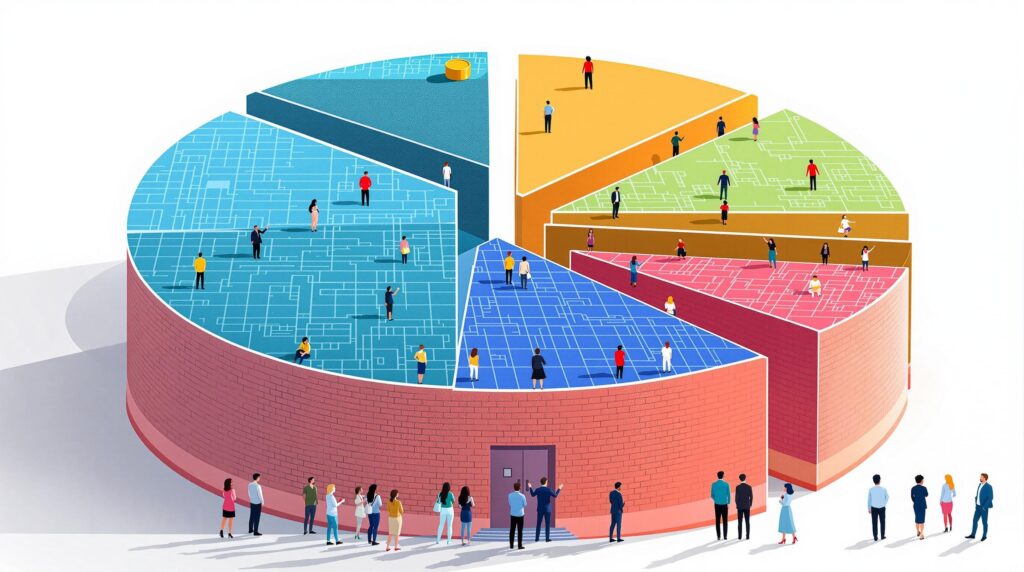[rev_slider alias=”slider-1″][/rev_slider]
The Rise of Layer 1 Blockchains: Transforming the Web3 Landscape
Imagine a world where traditional financial systems and digital innovations merge seamlessly, creating a new era of financial inclusion and economic security. This vision is rapidly becoming reality thanks to the rise of Layer 1 blockchains, which are paving the way for a decentralized global economy that’s more equitable and accessible than ever before.
What are Layer 1 blockchains? Layer 1 blockchains form the foundational architecture of blockchain platforms, providing the core protocols and security mechanisms necessary for decentralization.
However, you might wonder, why is there so much buzz around Layer 1 blockchains? These technologies, including well-known platforms like Ethereum and Bitcoin, serve as the bedrock for the growing Web3 ecosystem. They enable decentralized applications (dApps) to operate without intermediaries, fostering a robust digital landscape where user autonomy and data privacy are prioritized.
The Importance of Layer 1 Solutions
Layer 1 blockchains are vital because they build the trust infrastructure necessary for blockchain technology. By offering decentralized, tamper-proof records, these blockchains ensure data integrity and security in digital transactions. But what really sets Layer 1 solutions apart?
- Security: Layer 1 blockchains are designed to be highly secure, preventing dangerous breaches that could undermine trust in blockchain technology.
- Decentralization: These platforms eliminate the need for central authorities, increasing network trust by distributing control across numerous participants.
- Scalability: Despite traditional challenges with scalability, ongoing innovations continue to address and improve transaction speeds and throughput.
The overall goal is to create a world where digital interactions and financial activities are more transparent and accessible to everyone—especially in regions like Africa where technological advancements can significantly impact the economy. With platforms like Jara spearheading developments in African digital space, the potential for growth and transformation is immense.
“Jara is not just about creating financial opportunities; it’s about revolutionizing the African digital asset economy with cutting-edge blockchain solutions and strategic alliances.”
How Layer 1 and Layer 2 Blockchains Interact
To understand the future of Layer 1 blockchains fully, one must also consider Layer 2 solutions. These solutions operate on top of Layer 1 blockchains, enhancing their capabilities by improving efficiency and reducing fees, without compromising on security. Consider it like an express lane added to a busy highway: it doesn’t replace the highway but improves travel time for specific vehicles.
- Layer 2 Solutions: Built atop Layer 1, these solutions process transactions off-chain, reducing load and congestion, thus speeding up operation.
- Scalability: Layer 2 enhances scalability, making it feasible for large-scale adoption of blockchain technology across diverse applications.
By understanding these dynamics, companies like Jara are positioning themselves at the forefront of Africa’s digital revolution. They aim to bridge global capital with African digital assets, harnessing the power of both Layer 1 and Layer 2 blockchains to create a revolutionary economic ecosystem.
“Invest in $JARA: Fueling Africa’s $200B+ digital asset economy through innovative Layer 2 blockchain technology.”
A pivotal project example is the tokenization of the Lagos airport, showcasing how infrastructure projects can be redefined using blockchain solutions. This endeavor not only opens doors to a plethora of investment opportunities but also catalyzes economic empowerment across the continent.
Could Layer 1 blockchains be the future of Web3? As we continue to witness technological advancements and growing interest in decentralized solutions, Africa stands at the brink of a digital investment renaissance, propelled by visionary platforms such as Jara and the strategic use of blockchain and tokenization technologies.
Understanding Personal Injury Law: An In-Depth Guide
What is Personal Injury Law?
Personal injury law, also known as tort law, enables individuals who have suffered harm from accidents or injuries to receive compensation. The law operates under the premise that when someone causes harm through negligence or careless behavior, they should be held accountable.
“Your injuries are not just physical; they affect every aspect of your life. Let us help you reclaim it.” – Our law firm puts your recovery first.
Common Types of Personal Injury Cases
Personal injury cases generally fall into several distinct categories. Understanding each one helps in recognizing the nature of your case and in choosing suitable legal assistance.
- Car Accidents: Most personal injury claims arise from car accidents. When a driver fails to exercise reasonable care, they may be deemed legally liable for resulting damages.
- Slip and Fall: Property owners have legal responsibilities to ensure safe premises. When negligence leads to slips and falls, victims may seek compensation.
- Medical Malpractice: Occurs when a healthcare professional fails to provide the standard of care, possibly leading to injury or worsening conditions.
- Product Liability: Involves injuries caused by defective or dangerous products. Manufacturers are often held liable in these cases.
- Workplace Accidents: Injuries stemming from unsafe work environments or practices can result in claims, typically governed by workers’ compensation laws.
How Do Personal Injury Claims Work?
The process of pursuing a personal injury claim typically involves several critical steps:
- Gathering Evidence: Collect relevant details like medical reports, police records, and witness statements to establish your case.
- Contacting an Attorney: Legal experts can guide the process, ensuring you understand your rights and potential compensation.
- Filing a Claim: Your attorney will lodge a claim with the respective party’s insurance company or file a lawsuit to initiate formal proceedings.
- Negotiating a Settlement: Most personal injury cases resolve outside the courtroom through settlement negotiations to provide fair compensation swiftly.
- Going to Trial: If settlements aren’t reached, the case proceeds to trial where a judge or jury determines the outcome.
“In seeking justice, knowing when to settle can be as empowering as winning in court.” – Our attorneys offer guidance every step of the way.
Signs You Need a Personal Injury Lawyer
While you can handle minor claims on your own, complex cases require professional legal expertise. Consider hiring a lawyer if:
- Severity of Injury: Serious injuries entail ongoing medical care and long-term repercussions. Professional guidance ensures fair compensation.
- Insurance Company’s Response: If the insurer disputes your claim or offers insufficient settlement, legal support can provide leverage.
- Multiple Parties Involved: Accidents involving several stakeholders can complicate claims, demanding a strategic legal approach.
Compensation in Personal Injury Cases
The aim of a personal injury claim is to secure compensation sufficient to cover the injury’s impact. Compensation falls into several categories:
| Type of Compensation | Description |
|---|---|
| Medical Expenses: | Includes costs for hospital stays, surgeries, medications, and future medical care. |
| Loss of Income: | Covers wages lost due to inability to work and may include loss of future earning potential. |
| Pain and Suffering: | Compensates for physical pain and emotional distress caused by the injury. |
| Property Damage: | Reimbursement for damage to personal property, like vehicles or electronics. |
Choosing the Right Personal Injury Lawyer
Selecting the right personal injury attorney involves several considerations:
- Experience and Expertise: Look for a lawyer with a proven track record in handling personal injury cases similar to yours.
- Reputation: A good reputation within the legal community and positive client testimonials can provide peace of mind.
- Communication: Your lawyer should be approachable, responsive, and willing to explain the legal process clearly.
“Choosing the right advocate can transform your legal journey from daunting to empowering.” – Rely on our experienced team to support you.
FAQs About Personal Injury Law
Considering filing a personal injury claim? Here are answers to some frequently asked questions:
- How long do I have to file a personal injury claim? The statute of limitations varies by state and type of claim, typically ranging from one to six years.
- What if I am partially at fault for the accident? States have different rules. Some follow “comparative negligence,” allowing you to recover damages minus your fault percentage.
- Can I afford a personal injury attorney? Many work on a contingency fee basis, meaning you only pay if you win your case.
Conclusion
Understanding personal injury law is crucial to navigating your case effectively. By educating yourself and choosing qualified legal representation, you can secure the justice and compensation you deserve. Our firm is ready to stand by your side and champion your cause. Contact us today to start your journey toward recovery and justice.
[rev_slider alias=”text-call-cta”][/rev_slider]
Exploring the Trial Process: What to Expect
Facing a trial can be daunting. Understanding what to expect can significantly ease your worries. Let’s break down the trial process into manageable pieces.
Pre-Trial Procedures
Before walking into a courtroom, there are several pre-trial steps to consider.
- Discovery: This is the exchange of information between parties. You’ll gather evidence, witness lists, and legal documents. Think of it as preparing your toolbox for the trial.
- Motions: Both parties might file motions to resolve legal issues before the trial commences. Motions can range from dismissing the case to excluding certain evidence.
The Trial
Once pre-trial activities are concluded, the trial officially begins.
The trial is your stage, where evidence meets argument, and outcomes are determined.
- Jury Selection: This critical step sets the stage. Both sides ask potential jurors questions to ensure an impartial jury.
- Opening Statements: Each lawyer presents a roadmap of their case, outlining the story they intend to prove.
- Presentation of Evidence: Witnesses are called, and evidence is presented. Picture this as constructing a narrative piece by piece.
- Closing Arguments: Lawyers summarize their case, emphasizing key evidence to sway the jury.
Verdict and Sentencing
The trial culminates with a verdict. But what happens next?
Remember, the verdict isn’t the end; it’s the beginning of resolution or appeals.
- Jury Deliberation: After closing arguments, the jury retreats to deliberate and reach a verdict.
- Sentencing: If found guilty, sentencing follows. This step defines the penalties or legal relief granted.
Navigating the Appeals Process
If the trial doesn’t end in your favor, don’t lose hope. The appeals process provides a pathway to challenge an unfavorable verdict.
Understanding the Grounds for Appeal
Not every trial results can be appealed. There must be legal grounds.
- Legal Errors: Mistakes made during the trial, such as improper jury instructions or evidence admission issues.
- Juror Misconduct: Any form of improper behavior by jurors can be grounds for appeal.
An appeal isn’t a re-trial; it’s a review of the legal process for errors.
The Appeal Process Explained
Appealing a verdict involves several stages, each crucial to the potential for a new outcome.
- Notice of Appeal: This formal document notifies the courts and the opposing party of your intention to appeal.
- Record Preparation: The trial court record is prepared and transmitted to the appellate court for review.
- Briefs Submission: Both parties submit written arguments to the appellate court.
- Oral Arguments: Although not always required, they provide an opportunity to discuss the key points in front of judges.
- Decision: The appellate court reviews the case and issues a decision, which can affirm, reverse, or remand the case back to the trial court.
Common Legal Terms You Should Know
Understanding legal jargon can empower you in navigating your case effectively.
| Term | Definition |
|---|---|
| Plaintiff | The party who initiates a lawsuit. |
| Defendant | The party being accused or sued in a court case. |
| Verdict | The decision reached by a jury on matters of fact. |
| Subpoena | An order for someone to attend court, potentially as a witness. |
“Knowledge is power” – A firm grasp of legal terms strengthens your position.
Frequently Asked Questions
These are some of the most common queries potential clients have:
- Do I need a lawyer for a trial? Yes, having a skilled lawyer increases your chances of success as they understand the complexities of legal procedures.
- How long does an appeal take? The appeals process can take months to years, depending on the complexity and jurisdiction.
- What if I can’t afford a lawyer? Many law firms offer free consultations or work on a contingency basis where fees are collected only if you win.
Conclusion
Your legal journey, whether at trial or through an appeal, can be likened to a marathon—preparation and guidance make all the difference in reaching the finish line successfully.
Understanding Personal Injury Claims
When you’re dealing with an injury that’s someone else’s fault, navigating the complexities of a personal injury claim can seem daunting. This is where having a grasp of what personal injury claims entail and how to approach them can make all the difference. Let’s break this down.
What is a Personal Injury Claim?
A personal injury claim is a legal request for compensation filed by someone who has suffered harm due to another party’s negligence. These claims often revolve around instances such as car accidents, medical malpractice, and slip and fall accidents.
The primary goal of personal injury claims is to restore the financial status of the injured person as if the injury never occurred.
Steps to Filing a Personal Injury Claim
Filing a personal injury claim involves a series of steps that require careful execution to ensure the best possible outcome. Here’s an overview:
- Seek Medical Attention: Immediately after an injury, your health should be your top priority. Seeking medical care not only ensures your well-being but also provides critical documentation for your claim.
- Document the Incident: Record all the details surrounding the incident. Photographs, witness statements, and other evidences are vital to building a strong case.
- Consult a Personal Injury Lawyer: Engaging with an experienced lawyer can guide you through the legal process, helping to maximize your compensation.
- File the Claim: With your lawyer, file your claim with the at-fault party’s insurance company. This includes presenting evidence and a comprehensive account of how the injury has affected your life.
- Negotiation and Settlement: Most personal injury cases are settled out of court through negotiations. Your attorney will advocate on your behalf to secure a fair settlement.
Common Types of Personal Injury Cases
Personal injury law encompasses a wide range of incidents. Here’s a look at some common types:
- Car Accidents: These are among the most frequent personal injury claims, typically involving distracted driving, speeding, or DUI cases.
- Slip and Fall: Property owners can be held liable for accidents caused by unsafe conditions like wet floors or uneven surfaces.
- Medical Malpractice: This occurs when healthcare professionals fail to provide the standard of care, resulting in patient harm.
- Product Liability: Injuries caused by defective products can lead to claims against manufacturers and retailers.
“Your Voice, Our Mission” – we champion your rights with the tenacity and dedication that has earned us the trust of our community members.
Key Components of a Personal Injury Case
Understanding the components of a personal injury case can help in deciphering its potential success. These components include:
| Component | Description |
|---|---|
| Liability | The obligation of a party at fault to compensate the injured party. |
| Evidence | Includes medical records, witness statements, and other documentation supporting the claim. |
| Damages | The financial, physical, and emotional suffering endured due to the injury. |
| Negotiation | The process of reaching an agreement on the settlement amount with the insurance company. |
The Role of a Personal Injury Lawyer
Having an experienced personal injury lawyer is crucial for the following reasons:
- They offer legal expertise and understanding of complex laws.
- They handle communications and negotiations with insurance companies.
- They collect and present evidence to strengthen your case.
- They represent your interests to achieve fair compensation.
Having the right attorney can significantly affect the outcome of your case and the compensation you receive.
Understanding Compensation in Personal Injury Cases
Compensation in personal injury cases aims to cover various aspects of the victim’s life affected by the injury. This includes:
- Medical Expenses: Covers past and future medical bills related to the injury.
- Lost Wages: Reimbursement for lost income and potential future earnings.
- Pain and Suffering: Financial compensation for physical pain and emotional distress.
- Property Damage: Covers repairs or replacement of damaged belongings.
Factors Influencing the Value of a Claim
The potential value of a personal injury claim can be influenced by several factors:
- Severity of Injury: More severe injuries often result in higher compensation due to extensive medical treatment and impact on life.
- Clear Liability: Clearly establishing the fault of the defendant enhances the likelihood of a favorable settlement.
- Impact on Lifestyle: The degree to which an injury affects daily life and personal relationships also factors into the claim amount.
Your path to justice is our privilege to pursue. We understand the balance between legal expertise and client comfort.
Insurance Companies and Personal Injury Claims
Dealing with insurance companies is a critical part of personal injury claims. Here are a few things to keep in mind:
Challenges Encountered
- Delaying Tactics: Insurance companies might delay processes to pressure you into accepting lower settlements.
- Disputed Liability: Insurers may dispute the degree of fault to minimize payouts.
Strategies for Negotiation
- Be prepared with extensive documentation and evidence.
- Engage a seasoned negotiator – your attorney can often reach a better settlement than you could alone.
- Be patient and persistent, waiting for a fair offer can make a difference.
Conclusion
Every personal injury case is unique, requiring personalized attention and expertise. Our law firm stands ready to assist you through every step of the process, ensuring you receive the fair compensation you deserve.
[rev_slider alias=”schedule-consultation-btn”][/rev_slider]

What is a Layer 1 blockchain?
What is a Layer 1 blockchain? A Layer 1 blockchain is the base layer of the blockchain architecture that acts as the foundational network for decentralized computing. This includes well-known platforms like Ethereum and Bitcoin.
How do Layer 1 blockchains differ from Layer 2 solutions?
Layer 1 blockchains operate as the main chain where all transactions and smart contracts are directly processed. In contrast, Layer 2 solutions are secondary frameworks built on top of Layer 1 to enhance scalability and transaction speed by offloading some processes.
Are Layer 1 blockchains sustainable in the long term?
The sustainability of Layer 1 blockchains often depends on their ability to overcome challenges like scalability and energy consumption. Ongoing innovations, such as the shift from proof-of-work to proof-of-stake, aim to address these issues, increasing their long-term viability.
What is the role of Layer 1 blockchains in Web3?
Layer 1 blockchains play a critical role in Web3 by providing the core infrastructure necessary for a decentralized internet. They facilitate secure and transparent financial transactions, app development, and data sharing, making them integral to the future of digital economies.

Additional Related Pages
Explore more about our focus areas for a comprehensive understanding of our work in the field of blockchain technologies.
Discover What Our Clients Are Saying
Serving our Layer 1 and Layer 2 blockchain solutions clients with complete dedication, every case is a testament to our hard work. The appreciative feedback we receive underscores our commitment to excellence.

[rev_slider alias=”slider-3″][/rev_slider]
[rev_slider alias=”slider-6″][/rev_slider]
Explore the Future of Blockchain with Jara
Experience the transformative power of Layer 1 and Layer 2 blockchain solutions with Jara. By bridging global capital to African assets, we empower vibrant digital economies with innovative blockchain technology.
Interested in how Layer 1 blockchains can revolutionize your interaction with digital currencies and decentralized platforms? At Jara, we specialize in making complex blockchain technologies accessible to everyone. With our latest innovations, we provide the tools you need to thrive in a Web3-driven world.
Don’t just take our word for it. We are recognized as leaders in the blockchain industry, with several accolades highlighting our commitment to excellence:
- Honored among the “Top Blockchain Innovators” for 2023 by Blockchain Insights – See Award Details
- Highlighted in the “Best Emerging Tech Companies” list for 2023 by Tech Tomorrow – See Award Details
- Named in the “Influential Blockchain Startups” for 2023 by Crypto Leaders – See Award Details
- Selected for the “Innovative Financial Tech Award” 2023 by FinTech Arena – See Award Details
- Featured in the “Global Impact Blockchain Solutions” 2023 by International Tech Journal – See Award Details
Join us on this pioneering journey to harness the future of blockchain technology. Download the Jara app from Google Play or App Store to get started. For more information, visit our website or contact us at [email protected].
Chinyere “Chi” Nnadi Bio
Founder and CEO, Jara | Web3 and Layer 1 Blockchain Specialist
Content reviewed by Chi Nnadi and his content team. Chi is an experienced entrepreneur dedicated to transforming Africa’s financial ecosystem through blockchain technology. As Founder and CEO of Jara, he builds enterprise-grade infrastructure that converts illiquid African assets into globally accessible digital tokens. With proprietary Layer-2 blockchain technology and expertise in digital assets, Chi bridges the gap between global investors and Africa’s growing digital asset market.
Our Content Review Process
Chi Nnadi along with Jara’s dedicated content team, pledge to offer top-notch material. Our content guidelines ensure thoroughness, reputable sources, unbiased scrutiny, and other quality metrics. Please let us know if there is anything you believe to be inaccurate.
















